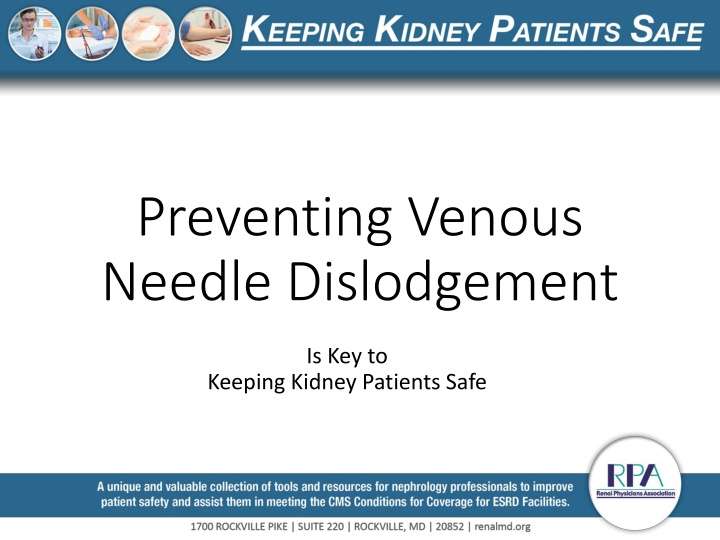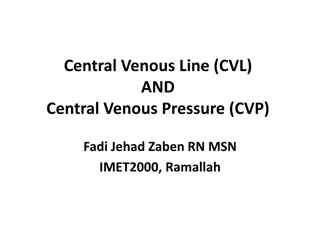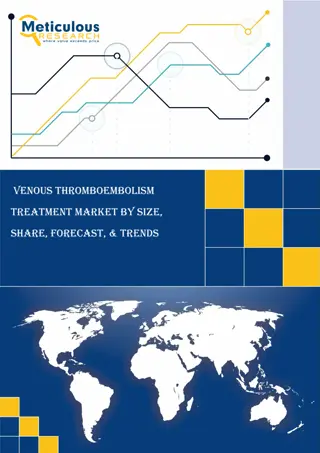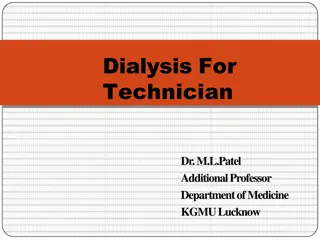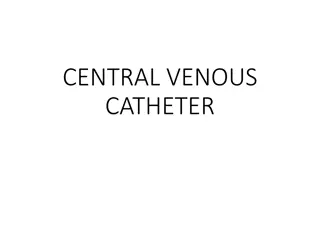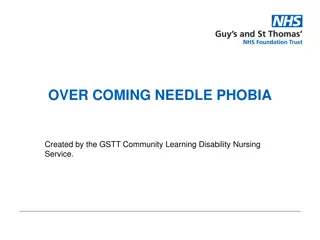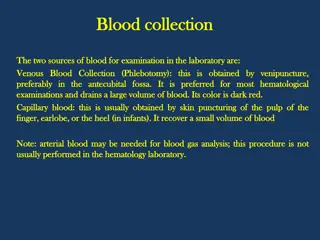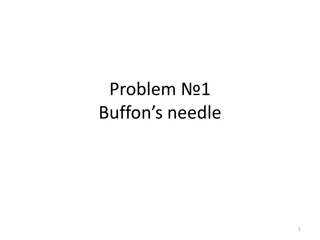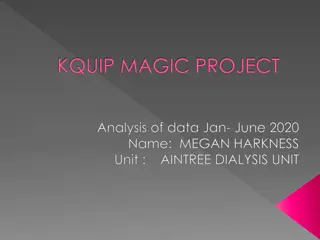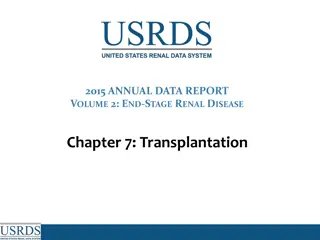Venous Needle Dislodgement in Dialysis Patients
Venous Needle Dislodgement (VND) is a serious complication of hemodialysis that can lead to significant blood loss and even mortality. It occurs when the venous fistula needle becomes dislocated, resulting in blood loss ranging from minor to fatal. The risk factors, consequences, and frequency of VND incidents highlight the importance of prevention and prompt response in dialysis care to ensure the safety of kidney patients.
Download Presentation

Please find below an Image/Link to download the presentation.
The content on the website is provided AS IS for your information and personal use only. It may not be sold, licensed, or shared on other websites without obtaining consent from the author.If you encounter any issues during the download, it is possible that the publisher has removed the file from their server.
You are allowed to download the files provided on this website for personal or commercial use, subject to the condition that they are used lawfully. All files are the property of their respective owners.
The content on the website is provided AS IS for your information and personal use only. It may not be sold, licensed, or shared on other websites without obtaining consent from the author.
E N D
Presentation Transcript
Preventing Venous Needle Dislodgement Is Key to Keeping Kidney Patients Safe
What is Venous Needle Dislodgement (VND)? A complication of hemodialysis that occurs when the venous fistula needle becomes dislocated out of the vascular access, resulting in blood loss. Ranges from minor blood loss to exsanguination (bleeding to death). Axley, B., Speranza-Reid, J., & Williams, H. (2012). Venous needle dislodgement in patients on hemodialysis. Nephrology Nursing Journal, 39(6), 435-445.
What Causes Venous Needle Dislodgement (VND)? VND occurs when the needle delivering the cleansed blood from the machine back into the patient either partially or completely comes out of the access site. Instead of the blood being pumped back into the patient s bloodstream, it flows onto the bed, chair and even the floor.
Facts about VND About 414 episodes of VND annually in dialysis population of 350,0001 Mortality range estimated between 10-33% percent1 The number of fatal incidents in the United States may be between 40 and 1361 5% of patients report that VND occurred within the past 3 months2 77% of dialysis nurses report seeing VND within the past 5 years2 1. Sandroni, Stephen , MD, Terry Sherockman, RN, MS, and Kathy Hays-Leight RN, Allegheny General Hospital, Pittsburgh. Presented at ASN/Renal Week, Philadelphia, US, November 2008. 2. Beckie Michael, Venous Needle Dislodgement, Kidney News 4
Facts about VND The most likely time for a VND incident is the last two hours of dialysis. The patient may become restless and inadvertently pull out the needle. In less than 7.5 minutes an average-size man receiving dialysis treatment can lose more than 40% of his blood volume from an undetected VND. An average-size woman can lose more than 40% of her blood volume in less than 5 minutes. It is considered a Class IV Hemorrhage, and it can be fatal without a rapid response.2 The Human Body - How Much Blood Is In the Average Human Body? http://www.enotes.com/science-fact-finder/human- body/how-much-blood-average-human-body 5
Consequences of VND Patients who lose more than 40% of their blood are more likely to suffer from permanent life-altering consequences such as stroke, and other permanent disabilities. Instances of VND can be expensive, requiring emergency care, hospitalization. 6
Risk Factors The VA National Center for Patient Safety found two major risk factors for bleeding during dialysis: 1) 75% of the most severe bleeds occurred in patients who were restless, confused, agitated, or uncooperative, and 12.5% in patients who were asleep. 2) Approximately 50% of the severe bleeds occurred outside of the chronic dialysis unit (in the ICU or in isolation rooms). 3) In 50% of the severe bleeds, the access site was not visible at the time of the event, and in the remaining 50%, the visibility of the access site was not documented in the root cause analysis. 7
Risk Factors Patients whose access is covered during dialysis Patients who are mentally, cognitively, neurological impaired, such as those with dementia Patients who are uncooperative, agitated or restless Patients with frequent blood pressure drops or muscle cramps Patients with extensive hair growth around the access points which makes fixation of the needles more difficult. 8
Risk Factors Patients with skin conditions, e.g., allergies to patches, eczemas, extensive sweating Patients with fistulas located other than cephalica or brachea, e.g. locations which are not visible easily submitted to friction Patient with known small blood leakage oozing around venous needle Patients with diabetes and frequent hypoglycemic episodes during HD therapy 9
Preventing VND Visually monitoring the status of the needle insertion site and blood lines is the first line of defense in detecting VND. The access site should remain uncovered allowing for easy visual inspection. Patients who are confused/agitated should be as close to the nurse s station as possible to make it easier to monitor them. 10
Preventing VND The needle should be taped securely. All staff should use the same taping technique, such as a butterfly or chevron pattern, as well as the same materials, where possible. Use of standard taping procedure makes it easier for staff to identify insecure initial fixation and any movement of the tape during dialysis. 11
Preventing VND Blood lines should be anchored to the patient and not the chair or bed. This reduces the chance that the lines could be pulled on hard enough to dislodge the needle. Blood lines should be looped loosely to allow movement of the patient and to prevent blood lines pulling on the needles
Preventing VND Set the venous pressure alarm as close as possible to the current venous pressure, and setting it asymmetrically. [For example: -30 and +70 mm Hg] will reduce the number of false alarms related to movement. 13
MODULE6Needle Dislodgement Preventing VND Smaller-bore needles may increase risk, as they create significant flow resistance, producing back pressures that greatly exceed the patient s venous pressure. As a result, the venous pressure monitor is likely to continue sensing the pressure created by the needle s flow resistance even if the needle is dislodged from the patient. Undetected Venous Needle Dislodgement during Hemodialysis. Hazard [Health Devices November 1998; (11):404-61]. http://www.mdsr.ecri.org/summary/detail.aspx?doc_id=8300 14
Engage Patients and Caregivers Staff, patients and care givers all should be aware of VND and the consequences. Clear policies and procedures should be developed regarding access sites. All patients should be assessed for their level of risk of VND, and if appropriate, an alarm device intended for monitoring venous needle dislodgement should be used. 15
Additional Tools for Preventing VND Enuresis pads may be used to detect blood loss from the access site. The moisture detector is positioned close to the venous needle, or between the two needle sites. HemaClip patient connector clips may be used to decrease the possibility of loosening or disconnection of the return blood line at the dialysis catheter. An optical sensor may be used to detect bleeding. The alarm reacts to the first drop of blood with an audible alarm and a flashing red lamp on the alarm unit. 16
Recommendations Inform dialysis staff that secure needle placement is crucial to avoiding dislodgments. Take the time to securely tape the needle to the patient's skin, arm, or access device. Alert dialysis staff to the dangers associated with relying on the venous pressure alarm to detect a venous line needle dislodgment. Advise them to continually examine hemodialysis blood lines during treatment if this is not already routine. Instruct users to keep the entire venous line from being covered by anything that might prevent good visualization of the needle insertion so that it can be easily monitored. Encourage users to continue to use the venous pressure monitor. While the monitor may not be able to detect a dislodged needle, it is useful for detecting obstructions or disconnections that occur elsewhere in the venous line. Instruct users to ensure that the monitor's alarm limits are set to clinically appropriate levels. 17
Developing Policies and Procedures Review current policies and procedures to ensure they meet current recommendations for preventing VND. Consider using a process analysis fishbone or other root cause analysis to examine policies and procedures. Review CMS Conditions for Coverage for ESRD Facilities. Review examples of Quality Assessment and Performance Improvement (QAPI) projects and develop QAPI projects appropriate for your facility.
Value of Standardized Systems Standardized systems reduce opportunities for error. Human errors can be caused by an individual s short- term memory, judgment impacted by long hours, or problem solving during a stressful event. Standardizing processes and systems minimizes the possibility for errors due to the human limitations that even the most vigilant professional can have. Standardized systems will give staff the strength to decrease variation in patient care and, ultimately, improve safety.
Develop System for Reporting Errors/Adverse Events All staff clinical, clerical, housekeeping, and maintenance as well as patients, need specific, written directions on how to report errors or adverse events. There should be discussions to ensure that all team members clearly know what staff is responsible for responding to errors and near misses immediately. A reporting form should be created for documentation.
Conduct Root Cause Analyses Once a continuing or evolving problem is identified through data tracking, the facility should conduct a root cause analysis to determine contributing factors, including a review of systems that were in place and determining if processes were followed. If not, there should be focus on staff training to prevent similar adverse events. If processes were followed but did not ensure patient safety, the Patient Safety Officer and other key staff should identify risks that could lead to further incidents and create solutions to prevent future errors that could lead to patient injury.
Which of the following should done prior to starting a patient s dialysis treatment? A. The access should be taped securely B. The access should be uncovered C. The blood lines should be looped loosely D. The patient should be assessed for risk of VND E. All of the above
Which of the following should done prior to starting a patient s dialysis treatment? A. The access should be taped securely B. The access should be uncovered C. The blood lines should be looped loosely D. The patient should be assessed for risk of VND E. All of the above
Who is at high risk for VND? A. Patients with skin conditions B. Patients with dementia C. Patients with frequent blood pressure drops D. Patients with covered accesses E. All of the above
Who is at high risk for VND? A. Patients with skin conditions B. Patients with dementia C. Patients with frequent blood pressure drops D. Patients with covered accesses E. All of the above
TRUE OR FALSE Blood lines should be anchored to the chair or bed to reduce the risk of VND.
TRUE OR FALSE Blood lines should be anchored to the chair or bed to reduce the risk of VND. FALSE Blood lines should be anchored to the patient.
Additional Resources Dialysis Safety: What Patients Need to Know http://www.renalmd.org/mpage/Patient_safety_tools Health and Safety Survey to Improve Patient Safety in End Stage Renal Disease http://www.renalmd.org/mpage/AboutKKPS ANNA Venous Needle Dislodgement Project https://www.annanurse.org/resources/venous-needle- dislodgement
Additional Resources The VA National Center for Patient Safety https://www.patientsafety.va.gov/docs/alerts/BleedingEpisodesDuringDial ysisAD09-02.pdf Venous Needle Dislodgement: How to Minimize the Risks https://www.ncbi.nlm.nih.gov/pubmed/19090893
